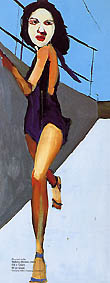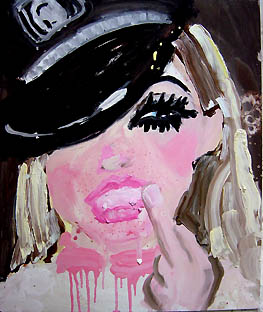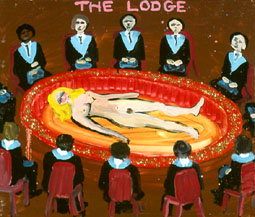Alex Michon's Guest Posting
My Friend Alex Michon has written a letter to Adrian Searle, the Guardian's art critic, in response to his article about Stella Vine's painting. I thought that it deserved to be published in some form especially as it is so nice about me so here it is.
Dear Adrian Searle
As one of the artists who showed work in the
Girl on Girl exhibition where
that painting (
Hi Paul Can You Come Over) was also exhibited and subsequently bought by Charles Saatchi, I was heartened to read your review in the Guardian on Wednesday 25 February:
Good Bad or Bad Bad?
After the 'filth and fury' tabloid frenzy it was interesting to read at least one critic who admits to not having seen the painting and who talks about the reproduction. Long after John Berger's 'Ways of Seeing' where he points out that the experience of viewing a reproduction is not the same as viewing the original work, it seems that many critics - holed up in their comfortable offices - are still all too happy to make judgements based on what is after all a duplicate/facimile (and an especially badly cropped one at that)
I was pleased to note that you referred to the "blood or rather red
paint that drools from Diana's lips" Up close and personal this fact is inescapable - paint or blood - blood or paint - it is the seminal
punctum of the piece. All at once there is a double take which adds greatly to the painting's drama.
If You Make a social Revolution do it for Fun
When you say that the painting is "fun - but hardly Picaso's Weeping Woman" we say hurrah! Contemporary art is surely just that contemporary of its time - as Picasso's woman was of its time and doubtless garnered similar criticism to Vine's. In the pick and mix tomfoolery jumble sale of contemporary art, artists are competing with and
informed by a tabloid sensibility of celebrity, to ignore this fact is surely to exist in a reactionary vacuum.
Again I must congratulate you for having done your research in referring to
Transition as an artist run space. But I am continually bemused as to how the galllery gets smaller and smaller with each mention of it, so that it eventually becomes
tiny. It is heartening to reflect that size is not necessarily an indication of either influence or importance.
The artist Cathy Lomax has for the past eighteen months been curating extraordinarily influential and interestting shows from an intensely personal vision and without any concern for market forces or what current art mores dictate. Cathy and Stella had recently been collaborating on a number of shows both at Stella's
Rosy Wilde gallery and at Transition. The two artists finding a common bond in a new sensibility. It is therefore widely disingenuous to state, as Richard Alleyne did in his recent piece
The Saatchi Effect has Customers Queueing For New Artist ( The Daily Telegraph 28 February 2004), that Stella "donated the portrait... to help fill the latest exhibition at her tiny gallery" The fact is that Cathy Lomax chose Stella's painting for the exhibition as she did all the other artists with an overall view of the aesthetic of the whole show (with the obvious limitations of space it is a wonder she could fit it all in!)
In the whole wind it up and spin it out of control farrago of British art where you point out "the rope is only six inches above the safety net" (after David Sylvester). It is perhaps interesting to look at the context in which this painting appeared.
Girl on Girl examined a new sensibility in art:
"Made by girls and about girls it makes a virtue of discontent, sexual disruptiveness and bad manners.. it has both the shy and the brash as equal role models. Think sense of conviction and to hell with the consequences because Girl on Girl is above all not about being nice"
The show was a definate gathering together of a shared method of work which explored an
emptional response to the subject matter. We were very aware of presenting a type of work which was hand-made and heartfelt, tongue in cheek and naughty.
Artists unlike critics or tabloid journalists, are on the front line, beavering away, (like kids in their tree houses) painting, making things, endlessly discussing, endlessly going to shows, supporting each oother, looking at things in a different way, trying to change the existing order, trying to loosen the establishment's hold on what is or is not allowed. Making a space for the work in the world, holding onto a personal vision, not doing it how you are supposed to - doing it your own way. We get down and dirty and we know there is no safety net, if there was one - achieving the triple in the air would not be half as exciting or extraordinary.
All this and more was written up in the
Girl issue of
Arty - the art fanzine referred to in your article and made especially for the exhibition. It also included interviews with new artistss in a 'slice of life' look at making work today.
Arty
Arty itself was started in 2001 by Cathy Lomax as an antidote to the kind of dry academic writing about art which was becoming increasingly elitist and out of touch with the kind of riky tiky, hand-made and heartfelt work which was appearing in miniscule galleries throughout the land.
You were right in your article when you stated that the fact that Stella had worked "on the fringes of the sex industry" had "turbo charged the story". Like one of Nigella's cakes, the exotic confectionary of a glamourous and tragic princess, a penniless artist and the allure of a titillating quasi 60s' Gipsy Rose Lee stripper (Stella had worked at The Windmill - ooh missus!) was too heady a mixture for the voracious tabloid monster to ignore.
But maybe - just maybe there is something at work here. For the painting to take such a hold on the nations consciousness (with even Fern Britton and Philip Scholfield on This Morning at loggerheads as to whether this painting was good bad or just bad) there has to be something else. An illusionary zeitgeist perhaps? Or just the fact that as the old/new YBAs prepare for yet another retrospective, what is longed for is, if not an overthrow of the existing order then at least a loosening of it?
You also write that "painters are mostly a conservative lot" . As someone who has just finished an MA, I can assure you that there are many so called conceptual artists being rehashed through colleges who are deeply rooted in a kind of stymied art speak and who are making work from a deeply conservative place. Painters are no less or more conservative than artists working in other media.
Much has been made of the fact that Stell Vine is self taught, shock horror! Where will it end? In the punk fanzine
Sniffin' Glue, Mark perry once drew three cords and wrote "here are three cords - now go out and form a band"
"Real life is elsewhere" - Arthur Rimbaud
Alex Michon - February 2004



























